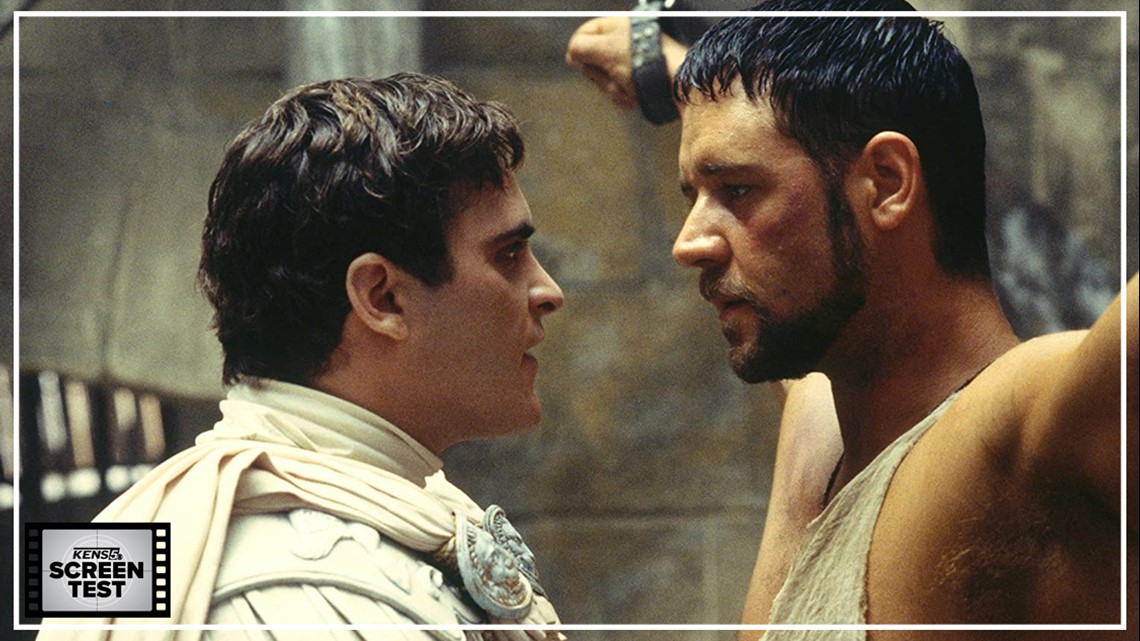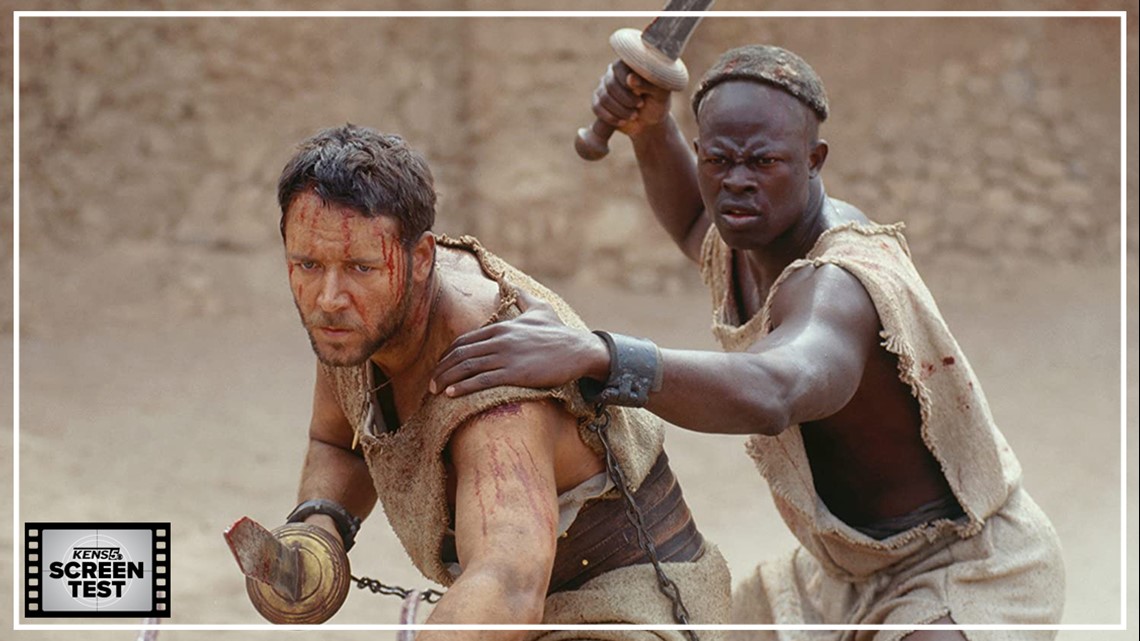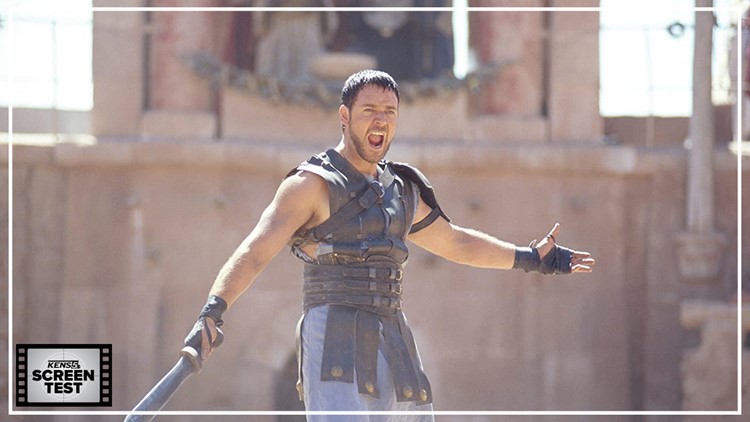“‘Spartacus’ was years ago, and that was the last important picture about Rome. So I think there’s an opportunity here—and maybe this will bring it back. Maybe it’s time for one like this.”
A white-bearded, white-toga’d Richard Harris said those words while taking a break on the set of “Gladiator” in 1999, suggesting – as did many of his costars – the significance of a Hollywood production the likes of which moviegoers had largely been deprived of since, well, Stanley Kubrick’s “Spartacus” nearly four decades earlier. Harris, the late Irish actor who portrayed Roman Emperor Marcus Aurelius in “Gladiator,” was right with his words. And he was wrong.
Enduring works like “The Matrix,” “The Sixth Sense” and “Fight Club” indicated a bold future for moviegoing at the turn of the century, buoyed by dazzling visual innovation, exciting new cinematic voices and a general affinity for making multiplex crowds go, “Wait, movies can do that?” And then there was Ridley Scott’s Roman-set revenge spectacular, which sought to make the masses think, “Wait, movies can do that again?”, this time with the aid of computer effects. In the process, “Gladiator” embraced an existential paradox that has crystallized in the two decades since: It was weaponizing the latest leaps forward in sparkling technical wizardry to take audiences back, and to revitalize a dormant genre that New Hollywood’s grittier, urban stories snatched studios’ attention away from. The mid-60s saw Francis Ford Coppola, Martin Scorsese and Sidney Lumet inspire modernized ways of thinking about movies. The allure of “Ben-Hur’s” chariot race was suddenly of another era; in came the intoxication of offers that couldn’t be refused. Even Kubrick went from the Roman Republic to space later in the same decade.
Oh, the swords-and-sandals picture was still being made, albeit in a slightly different tune. “Jason and the Argonauts” (1963), “Clash of the Titans” (1981) and “Conan the Barbarian” (1982) links the decades between “Spartacus” and “Gladiator,” but those movies signaled a self-awareness and enticement towards the fantastical. And even as the age of the indie movie was getting underway in the ‘90s, arms-wide-open drama still ruled the hearts of Academy Awards voters; “Schindler’s List,” “Braveheart,” “Titanic” and “Shakespeare in Love” all won Best Picture in the years leading up to “Gladiator.”


But, as Harris noted, not since “Spartacus” – and, in a less direct way, 1963’s “Cleopatra” – had the ornate environments and ornately savage politics of ancient Rome been depicted on the big screen with prestige motivations. Out were the sword-wielding skeletons of “Jason and the Argonauts” and skirmishes against Medusa of “Clash of the Titans.” In was the colossal, computer graphics-generated Coliseum; the brooding bloodlust of ruler and citizenry alike; and a story of personal vengeance on the part of Russell Crowe’s General Maximus (the name is appropriate, still) that the movie is never able to fully separate from its glee for violence. Crowe played Maximus with a bureaucratically-tinged practicality, his emotions rarely doing more than simmering underneath as his journey unfolds.
And there was fighting. Lots and lots and lots of fighting. As Crowe himself put it during the shoot: “We have that massive fight sequence at the beginning of the film, and that’s followed up by a series of massive fight sequences, building up to a massive fight sequence so we can end with a fight sequence I’d describe as massive.” The initial battle between the General Maximus-led army and the Germanic warriors is a pretty spectacle of brutality that is just decipherable enough. In one shot, the camera takes a breather from being intimate with the carnage to pan slowly – almost affectionately – across the battlefield as arrows fly and fires rage. “Here,” the film seems to be saying, “is your new epic.”
Twenty years on, even after the delicately-conceived battles of “Game of Thrones,” the massive fight sequences and general bombast of “Gladiator” still stand out, though not for the sheer infinity so much as how it’s meant to distract – mostly successfully – from a plot that is fairly simplistic in its ambition, and ultimately rote in its execution. It’s worth wondering if we should hold that against the film, seeing as how sheer scale may have always been the priority of this particular project (to the tune of an estimated $103 million budget). As it turns out, finishing the screenplay before the start of production wasn’t. While promoting “The Nice Guys” in 2016, Crowe said the script consisted of a grand total of 21 pages when shooting got underway. That wouldn’t be a problem if “Gladiator” was 30 minutes long. But its runtime is two and a half hours. “It’s the dumbest possible way to make a film,” Crowe said in 2016, saying that the screenplay’s evolution paralleled the production schedule. “He (Scott) had gone down there, he’d picked some locations, the sets were dressed. But we didn’t have any pages.”
As Crowe explains it, as the movie hopped from England to Malta to Morocco, “versions of what could possibly happen next kept arriving from different writers.” It’s a jump-off-the-plank way to make your Roman epic, to be sure, and at least as interesting a story as the narrative of “Gladiator” itself. But if any director could do it, it was probably Scott, who was working with the biggest budget of his career thus far after cementing his reputation with “Alien,” “Blade Runner” and “Thelma & Louise.” You may have heard of them.
Scott got the job done. But it’s not as if Crowe’s 2016 comments are entirely surprising. “Gladiator” is still effective at translating the weight that Maximus’s mission holds on him, thanks in large part to Crowe’s enduring resilience. But the movie only occasionally dips its toes into political nuance and is barely interested, if at all, in making sense of the magnificent hyperbole we remember it for. Joaquin Phoenix playing Commodus as a sociopath drunk on power he doesn’t know what to do with five minutes from any given moment is a treat as much as it’s nonsensical. This scene looking like an early version of a winter Instagram filter was slapped onto it. Hans Zimmer's score is an intimidating beast that's even more effective at conjuring audible reaction with its pathos (and Lisa Gerrard's siren-song voice). If someone were to say the film's starkly simplistic poster is either profoundly evocative or profoundly banal, I'd probably agree with them. And tension – legitimate tension – is virtually absent outside the arena. “Gladiator’s” focus on spectacle over story didn’t much impress critics who felt the movie was lacking a certain self-awareness or new ideas about a decades-old genre. In his New York Times review, Elvis Mitchell wrote that “the movie wants to criticize the crowds thirsting for violence, yet it doesn’t shy away from presenting gladiators wrestling with tigers.” Roger Ebert said, “it employs depression as a substitute for personality.” And the LA Times’s Kenneth Turan lamented how the film “hampers its momentum by spending too much time on predictable plot twists.”
Some critics were won over by the modernization of ancient spectacle, including the San Francisco Chronicle’s Mick La Salle (“Lots of action and intrigue”) Variety’s Todd McCarthy (“vital, visceral and pulse-quickening”) and the Chicago Tribune’s Michael Wilmington (“a magnificent throwback”).
In the world of the movie, the film’s supporters may be followers of Joaquin Phoenix’s maniacal Commodus, whose first act as emperor – after ordering the unsuccessful killing of Maximus – is to bring back gladiatorial combat at the Coliseum and win loyalty of the city. (It’s one of the movie’s narrative shortcomings that Rome’s denizens are so easily swayed after insulting Commodus upon his return to the city.) “The beating heart of Rome is not the marble of the Senate; it’s the sand of the Coliseum,” says Derek Jacobi’s Senator Gracchus upon watching the populace stream into the arena like it was Super Bowl Sunday. It’s a line that very well doubles as “Gladiator’s” reason for existing.
Justification turned into confirmation on the weekend of May 5, 2000, when the film opened across America and crowds similarly flocked to theaters—arenas in their own right. “Gladiator” led the weekend with $34.8 million – more than four times as much as the underwater thriller “U-571” – en route to a $187.7 million domestic haul, third-best for the year behind “How the Grinch Stole Christmas” and “Mission: Impossible II.”
It’s almost too easy to make the comparison between Roman audiences and moviegoing ones. As Gracchus also says: “Fear and wonder—a powerful combination.” Isn’t fear and wonder among the emotions that drive us to the movies anyway? Mitchell may have noted how the film’s (largely-digital) recreation of the Coliseum is “roughly the size of the Death Star,” but the moment in which we’re put behind the eyes of Maximus – now having secured a reputation as a mighty gladiator – as he gazes up at the structure stretching to the heavens is among those in the film that still inspires legitimate awe two decades later. (In our age of social distancing, the massive crowds filling one place also feels like an impressive scene from an alternate dimension.)
Of course, “Gladiator’s” most iconic line exemplifies its own success and the goal of the medium at large: Are you not entertained? Millions of moviegoers were.
So were Academy Awards voters. The film went on to notch a staggering 12 Oscar nominations, and, 10 months after its box office bow, it took home five of them—Best Picture, Best Actor, Best Costume Design, Best Sound and Best Visual Effects. It was the cherry on top...er...crown on the head of DreamWorks and Universal’s gamble. (“Gladiator” was also a rare disruptor of the adage that awards hopefuls must release in the fall to truly contend; “Crash” is the only other Best Picture victor in the 20 years since to have been released in May.)
Even in the movie’s biggest moment of the night, it was the accomplishment of realizing Rome on the big screen in a way Hollywood hadn’t before that preceded words of thanks to Scott, Crowe or anyone else. “It takes a lot of people to make a Coliseum,” is how producer Douglas Wick, statuette in hand, started his Best Picture speech. “To all the wizards who brought to life the sights, sounds and citizens of a faraway world, we should take a chisel to this statue and give you your fair share.”
So Harris’s word proved to be prophesy—in part. In the eyes of many, it was time for “Gladiator,” and perhaps for the swords-and-sandals epic once more. To quote another recent Best Picture winner, the film was the king of the world…and of CGI-ified Rome. Hollywood took note of the movie’s triumphs, and – as is wont to happen in the industry – replication ensued, budgets blossomed and expectations loomed.
But if “Gladiator” made audiences hungry for more offerings from this genre, later films both quenched and starved them. The next few years brought “Troy” and “Alexander,” but these films operate more as vehicles for their beautiful stars (Brad Pitt, Orlando Bloom, Colin Farrell, Angelina Jolie among them) than the genre they are working within. The battles feel less tangible, the reliance on visual effects more overzealous, the narratives more akin to a soap opera than a personal journey to contrast the grandeur. “Troy” made some money – $133.4 million in the U.S. – but with a budget nearly double that of “Gladiator,” it didn’t come close to replicating its financial success. And if “Troy” wasn’t a gladiator at the box office, “Alexander” could barely lift a sword; Oliver Stone’s movie made $34.3 million domestically against a budget nearly five times that amount. Not all Roman epics are cut out for the Coliseum, it seems—whether you want to link the metaphor to box office viability or Oscars triumph.
Still, like Maximus himself, the Hollywood of the new millennium persisted. To little avail. As moviegoers’ loyalties increasingly became one with the blooming Marvel Cinematic Universe, stories revolving around clanging swords and armored warriors and heroic prophesies started to resemble “Gladiator” less and more the gauzy fantasies of a young school child. Here’s a list of movies that might not have existed in the last 15 years if not for “Gladiator”: “Kingdom of Heaven.” “Centurion.” “Immortals.” “Exodus: Gods and Kings.” “Prince of Persia: The Sands of Time.” “Hercules.” “The Legend of Hercules” (if you’ll remember, those both showed up in theaters in 2014. Your move, Spider-Man). “Gods of Egypt.” “Pompeii.” “King Arthur: Legend of the Sword.”
At some point, these all start to resemble the same movie. And they kind of are—massive projects with massive $100 million budgets (some of them closer to $200 million) that increasingly hope a fetishistic abundance of visual effects will be enough to attract even a fraction of the audiences that Iron Man and Captain America are drawing. Oscar triumph was about as likely as a Best Picture win for “Trolls 2.” For the most part, they’re exceptionally unexceptional, in quality and money-making ability. Even Ridley Scott couldn’t recapture his “Gladiator” touch; “Exodus” and “Kingdom of Heaven” are both his films.


They were some exceptions. Zack Snyder made his name and staked his claim with 2007’s “300,” the nihilistically gruesome graphic novel adaptation about an over-achieving group of oiled-up Spartans that doesn’t use visual effects so much as it pumps them through its cinematic veins. The project cost just $65 million; it made north of $200 million. Maybe there was something to this rebirth of the genre after all, so long as it continues to reinvent itself? Most later movies would dash the hope, although there was 2010’s extravagant “Clash of the Titans” remake, the gods-against-gods epic with a rock-n-roll attitude that tried to capitalize on Sam Worthington’s rising star. The film’s forgettable, though it made a cool $163 million domestically. It’s follow-up, “Wrath of the Titans,” made just half that while costing more to produce. Call it the wrath of the genre.
It’s tough to separate each of the movies listed above from each other. It’s a testament to “Gladiator,” then, that its memorable threats and sweeping Hans Zimmer score and life-or-death bouts remain clearly imprinted on our moviegoing consciousness by comparison, even if the film’s cultural currency in 2020 is measured in memes.
There’s a moment early in “Gladiator” when Harris’s Marcus Aurelius wonders aloud, “will I be the emperor who gave Rome back her true self?” It feels like the movie commenting on a self-imposed responsibility to live up the works of Kubrick, William Wyler and Mervyn LeRoy that came decades before. While Marcus’s question lives on in the form of spirited debate, the man who played him was correct and also wrong. It was the right time for “Gladiator.” But perhaps not the right time for the Roman epic at large, its newfound potential and enduring influence notwithstanding. Audiences, it turns out, are as unpredictable and vicious as a tiger let loose in the Coliseum. Does Scott’s film – 21 pages of shooting at the start of production, 12 Oscar nominations, digitized Coliseum crowds and all – pave the way for the later success of “Game of Thrones?” We can never really know. TV is its own beast. But in the world of movies, nothing hoping to top “Gladiator” has really come close to meeting it on the Coliseum sand.
“There was a dream that was Rome,” Maximus says after winning his vengeance in the film’s gloriously self-satisfying final moments. “It shall be realized.” And it may, yet again. “Gladiator 2” is on the way.



